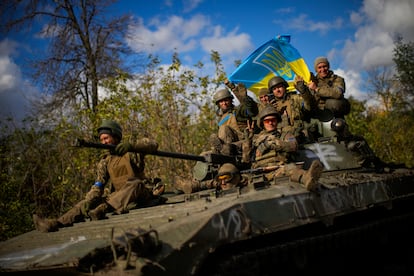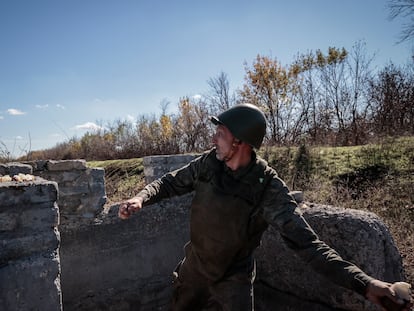Russia becomes the main (involuntary) supplier of weapons to Ukraine
Hasty troop withdrawal on the Kharkiv and Kherson fronts is providing hundreds of abandoned armored vehicles, howitzers and ammunition for Ukrainian forces

Images of farmers dragging abandoned Russian tanks behind their tractors has become a constant presence on social media. Ukrainians jokingly call these farmers the Agricultural Division to poke fun at the military setbacks suffered by Moscow against a theoretically inferior enemy. But the joke conceals a paradox: as its troops hastily withdraw, Russia has unintentionally become Ukraine’s main supplier of military equipment.
The Kremlin launched its invasion on February 24; only a month later, Ukrainian forces began to recapture territory in the regions of Kyiv, Chernihiv and Kharkiv, where retreating Russian troops left behind dozens of pieces of heavy equipment. The Wall Street Journal this week published a detailed list of Russian weapons added to the Ukrainian arsenal: “460 Russian main battle tanks, 92 self-propelled howitzers, 448 infantry fighting vehicles, 195 armored fighting vehicles and 44 multiple-launch rocket systems, according to visual evidence compiled from social media and news reports from Oryx, an open-source intelligence consulting firm.”
The figures on armored vehicles, if exact, exceed those delivered to Ukraine by its international allies: 320 tanks, 210 infantry fighting vehicles and 40 armored fighting vehicles. Russia also appears to have become the main source of artillery for the Armed Forces of Ukraine.
The Ukrainian army is not confirming whether these numbers are accurate, said a spokesman for the General Staff. The armored vehicles, according to Oryx’s count, would be equivalent to nearly half of the total that the Ukrainian army had in September, before the more recent offensives.
Armored vehicles are of vital importance for an army that wants to attack. Ukraine has launched a counteroffensive to retake the provinces of Kharkiv in the east, and Kherson in the south. For the first time in almost half a year, it has also gained access to towns in Luhansk, in the Donbas region. The numerical imbalance between the Russian and Ukrainian armies’ armored and artillery battalions is especially high, so capturing a T-90 tank, one of Russia’s military gems, is celebrated as a victory. Such was the case this week when the commander of the Ukrainian 92nd Mechanized Brigade, Colonel Pavlo Fedosenko, was filmed driving off in a T-90 while shouting with satisfaction about the tank’s maneuverability and speed. The 92nd Brigade has been one of the key units in the Ukrainian advance that has pushed the Russians out of Kharkiv province.
After a review of the mechanical state of the captured materiel, Russian identification symbols are deleted and replaced with Ukrainian ones. The most commonly captured vehicle, according to Oryx, are BMP-2 armored infantry transport vehicles. This week, a video of Russian soldiers surrendering in their BMP-2 on the Kherson front went viral on social media. As a white flag, a sign of surrender, they used underwear. Andrii Yusov, head of intelligence at the Ukrainian Defense Ministry, said on Tuesday that so far this fall, more than 2,000 Russian soldiers had called the telephone hotlines that the Ukrainian authorities have made available to enemy soldiers wishing to surrender.

Ukraine benefiting from Soviet-era training
The Ukrainian army is already familiar with many Russian weapons because most of the equipment has been shared since Soviet times. Vehicles that are damaged beyond repair are scrapped for parts. Artillery units are also reportedly capturing numerous T-12 anti-tank guns abandoned in ambushes carried out by small units that are more agile and better equipped than the less motivated Russian troops, who are also hampered by a more rigid structure and a less flexible chain of command. Images of Ukrainian anti-tank platoons armed with Russian Kornet portable missile launchers have also emerged in recent weeks.
The investigative organization Conflict Intelligence Team concluded last September that with the surprise counteroffensive in Kharkiv, Ukraine had achieved something extraordinary in a war situation: ending up with more armored vehicles than at the start of the battle.
Even so, Ukraine’s counteroffensive largely depends on the supply of modern weapons from its NATO allies. One of the best examples of the most advanced equipment that Ukraine is receiving from the West is the Lithuanian EDM4S Sky Wiper anti-drone device, which uses electromagnetic pulses to jam the navigational systems of enemy drones.
Ukraine’s ability to resist the Russian onslaught has been above all thanks to the better training of its soldiers and to weapons such as Turkish Barayktar drones, American M777 howitzers and the real star of this war, the HIMARS light multiple rocket launcher, also supplied by the United States. These weapons represent a milestone in the conflict because they are destroying supply networks and weapons depots in the Russian rearguard, forcing the invaders to move resources even further from the front.
So far in 2022, the US has sent Kyiv weapons valued at more than €2 billion and has made a commitment to send an additional €8 billion in military aid, according to calculations by the Kiel Institute for the World Economy (IFW). The United Kingdom is in third place after Poland (€1.8 billion) with a commitment to transfer weapons worth €1.33 billion.
Tu suscripción se está usando en otro dispositivo
¿Quieres añadir otro usuario a tu suscripción?
Si continúas leyendo en este dispositivo, no se podrá leer en el otro.
FlechaTu suscripción se está usando en otro dispositivo y solo puedes acceder a EL PAÍS desde un dispositivo a la vez.
Si quieres compartir tu cuenta, cambia tu suscripción a la modalidad Premium, así podrás añadir otro usuario. Cada uno accederá con su propia cuenta de email, lo que os permitirá personalizar vuestra experiencia en EL PAÍS.
¿Tienes una suscripción de empresa? Accede aquí para contratar más cuentas.
En el caso de no saber quién está usando tu cuenta, te recomendamos cambiar tu contraseña aquí.
Si decides continuar compartiendo tu cuenta, este mensaje se mostrará en tu dispositivo y en el de la otra persona que está usando tu cuenta de forma indefinida, afectando a tu experiencia de lectura. Puedes consultar aquí los términos y condiciones de la suscripción digital.
More information
Últimas noticias
Most viewed
- Sinaloa Cartel war is taking its toll on Los Chapitos
- Oona Chaplin: ‘I told James Cameron that I was living in a treehouse and starting a permaculture project with a friend’
- Reinhard Genzel, Nobel laureate in physics: ‘One-minute videos will never give you the truth’
- Why the price of coffee has skyrocketed: from Brazilian plantations to specialty coffee houses
- Silver prices are going crazy: This is what’s fueling the rally










































